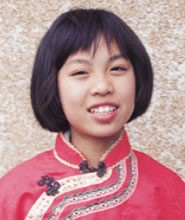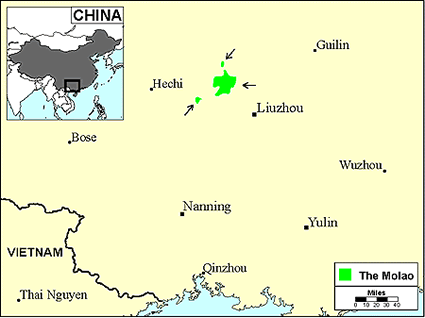The Mulao, also known as Mulam, are the descendants of the ancient Liao and Ling tribes of the Jin Dynasty (AD 265-420). For centuries the Mulao have struggled to prevent their ethnic identity from being swallowed up by the dominant Han Chinese, Zhuang, Miao and Dong groups. Today in the main center of Mulao civilization, Luocheng County, the Mulao no longer wear their traditional clothing. In addition, many Mulao youth now speak Mandarin as their mother tongue.
The Mulao are one of China's officially recognized minority groups. Some Mulao living in Luocheng refer to themselves as Kyam. In 1945 the Mulao were described as being a part of the Lao people in China, which also included the Gelao and Tulao tribes.
Mulao is a part of the Dong-Shui branch of the Daic linguistic family. It has ten tones, and shares 65% lexical similarity with Southern Dong and 53% with Northern Zhuang. Although Mulao is spoken by most members of the Mulao nationality, many are bilingual or multilingual in Chinese, Zhuang, and Dong. The Mulao have used the Chinese orthography for reading and writing since the Ming Dynasty (1368-1644).
Guangxi is home to some of the most exotic food in China. In addition to the normal helpings of dog and cat that are available throughout Southern China, mouthwatering dishes that appear on local menus include snake-vile soup, bamboo rat, mutjac-horned pheasant, short-tailed monkey brain, gem-faced civet, ants, fruit-eating fox, and last but not least, armadillo face. Mulao who bear the surname of Luo or Wu, however, are not allowed to eat dog meat or the internal organs of animals.
The Mulao used to be polytheists, but now religion does not play a large part in their everyday lives. In the past they observed the Yifan Festival. They sacrificed pigs and sheep, performed lion and dragon dances, and Mulao shamans chanted incantations.
Several Christian research organizations list a figure of 1,600 Mulao believers in China, but one recent visitor reported, "Nobody I spoke with had ever met a Christian before, and most did not even know what the word Christian meant." There are no reports of missionaries prior to 1949 specifically focusing on the Mulao. A 1997 article mentions a mud-brick and tile church building needing repair at Qiaoshan Village in Luocheng County, but it does not mention whether the members of this church are Han Chinese or Mulao.
Without the guidance of Christ, these people are like sheep without a shepherd. They need the good shepherd in their families and communities.
Pray for the authority of Christ to bind hindering spiritual forces to lead them from darkness to light.
Pray for signs and wonders to happen among them and for great breakthroughs with a rapid multiplication of disciples and house churches.
Pray for bold workers who are driven by the love of the Holy Spirit to go to them.
Pray for an unstoppable movement to Christ among them.
Scripture Prayers for the Mulao in China.
Operation China, Asia Harvest, Copyrighted © Used with permission
| Profile Source: Joshua Project |











